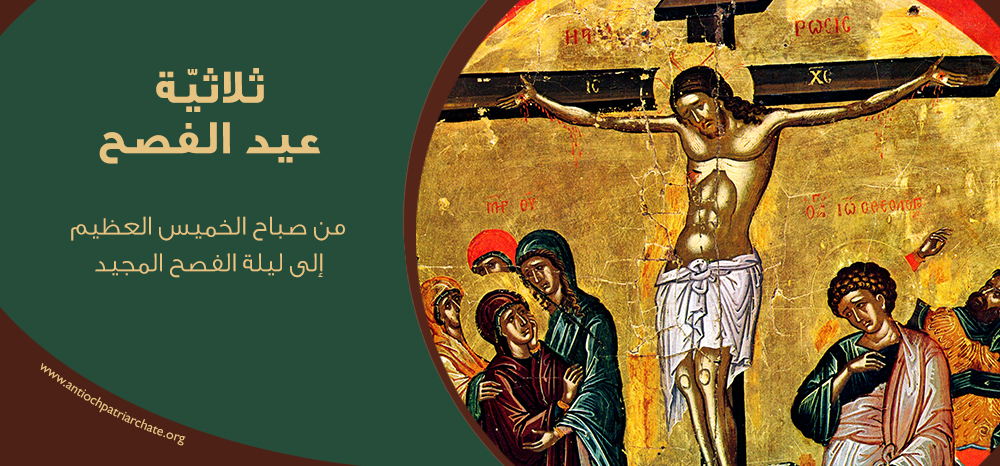
The Paschal Trinary
The Paschal Trinary
From Holy Thursday Morning to the Glorious night of Pascha
We cannot speak of the services of Holy Week without returning to the services that were held in the Church of Jerusalem, because of their importance, being the natural stage of the events of the suffering and resurrection of the Lord. This is a good reason for these services to have a great effect on the other churches. What is still preserved today of these ministries is inevitably derived from what prevailed in Jerusalem in the first centuries. Thursday and Friday of Holy Week were two days full of services and prayers that started early in the morning and did not end until late at night. This is what the Spanish pilgrim Egeria (4th century) tells us, having visited the holy places of pilgrimage and recorded what she was seeing. It was customary for worshipers to congregate in the churches located in the various important places where events related to Jesus took place, to perform services and prayers, and to read the corresponding passages. The twelve gospels that we read in the service of the Great Thursday are only a trace of this habit.
The services on Thursday and Friday ended early Saturday morning with the recitation of Matins service, which is the basis of the service that we call the "funeral of Christ" and that we perform nowadays on Friday evening. On the Sabbath, which comes after two days full of services, there was no prayer meeting until the evening. After the early ritual prayer, the worshipers went home and rested throughout the day without eating anything, waiting to participate in the Easter evening. Thursday and Friday are the most important days of the week after Easter, for we commemorate founding the sacrament of the Eucharist and the self-sacrifice of Jesus on the cross, which is the most important event in our Christian life, being the object of our faith and the hope of our salvation. Therefore, these two days are characterized by the intensity of services and the abundance of meanings.
Holy Thursday
1- Thursday morning
Holy Thursday introduces us to the Mystery of Pascha.
Four events are commemorated on Thursday of Holy Week: 1- The washing of the disciples' feet, 2-The institution of the Sacrament of the Holy Eucharist at the Last Supper 3- The agony in the garden of Gethsemane 4- the betrayal of Christ by Judas.
The first two events reveal the Lord's sincere love of the world. The third event reveals Jesus' obedience to God the Father until death. While the fourth event, i.e. the betrayal of Judah, shows the mystery of sin, which is the deviation and distortion of love towards something that does not deserve love. It is this mystery of sin that drove Christ to the cross.
On Thursday, then, we remember Jesus' last hours with his disciples, and his surrender and trial by the Jewish and Romanian authorities. Hence the main theme of this day is "love to the end":
“Jesus knew that His hour had come that He should depart from this world to the Father, having loved His own who were in the world, He loved them to the end (John 13:1). Love to the end extends to death, to the breaking of the flesh and the shedding of blood, this fact that Jesus revealed at the Mystical supper with his disciples as he established the secret of the Eucharist, recommending them to eat his body, drink his blood, and make what he did at this last supper for his remembrance.
Thus in every Divine Liturgy, we fulfill what Jesus commanded us to do. On this day, Jesus offered his Body and Blood as a sacrifice and entered into his sufferings. The meaning of the mysterious supper is that " man shall not live by bread alone ", but by the Bread that comes down to us from above, to increase satiation. God gives us food and drink in Christ Jesus.
A- The Matins Service
One of the hymns of Matins service summarizes the meaning of this day's rituals. The hymn says: " Let us all draw near to the mystical table in fear, and with pure souls
receive the Bread, remaining with the Master, that we may see how He washed
the feet of the disciples and wiped them with a towel; and let us do as we have
seen, subjecting ourselves to each other, washing one another’s feet. For such is
the commandment that Christ Himself gave to His disciples; but Judas, the
slave and deceiver, listened not."
This hymn invites us to come near the secret table where is found the mystery of the attic in which the Lord chose to make the Passover, to establish the taste of eternal life, and to show us humility by washing the feet of the disciples. At the same time, it describes Judah's betrayal. Thus, the hymns reveal how light and darkness, joy and sadness, mix ... This mixing shows that the peak time of love is also the peak time of betrayal. John the Evangelist says that when the disciples were gathered in the upper room, Judah left the light and went out, "and it was night" (13:30). That is because he wanted to show how darkness had controlled Judas, and he deviated from the love of his Creator, drowning in the love of the world in represented by the image of the thirty pieces of silver.
Thus the crucial question is asked to each one of us: Do I accept the love of Christ as my life or will I follow Judah to his dark night? Is my love for the Lord like the love of John who leaned on his chest, or is it like the love of Judah for the world and for what is in the world, a that casts its owner in the night, in outer darkness?
On the other hand, Lord warns Peter that he will deny his master three times before the rooster crows.
The Gospel of Matins therefore smacks us with the experiences of Judah's betrayal and Peter's denial: two of the twelve disciples! It confirms that wherever we might be, we are always under test. In the face of this painful slap, no one can be sure of himself. He either closes his hands and goes away with Judah, fleeing at night, and hangs himself, i.e. rejects the cross, or returns with Peter and cries bitterly and, having been baptized with tears of repentance, he deserves to see the resurrection.








